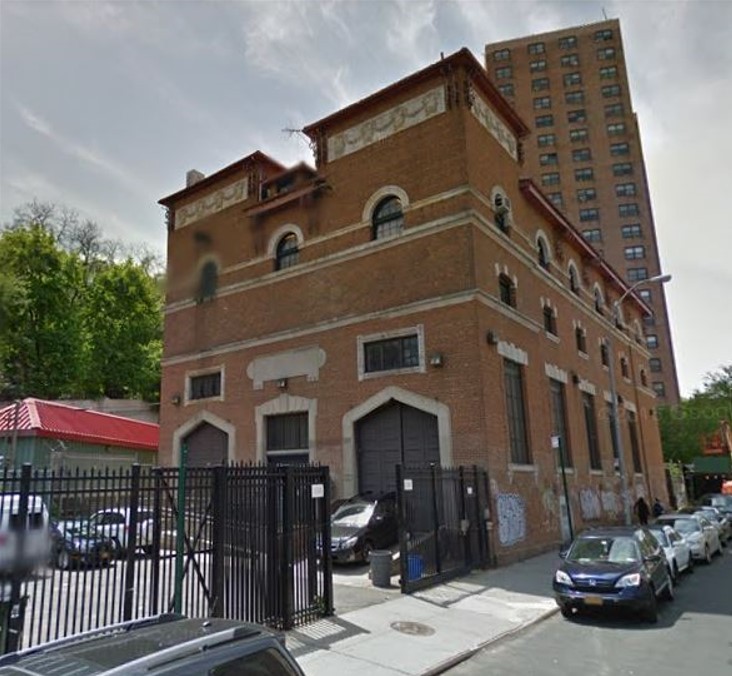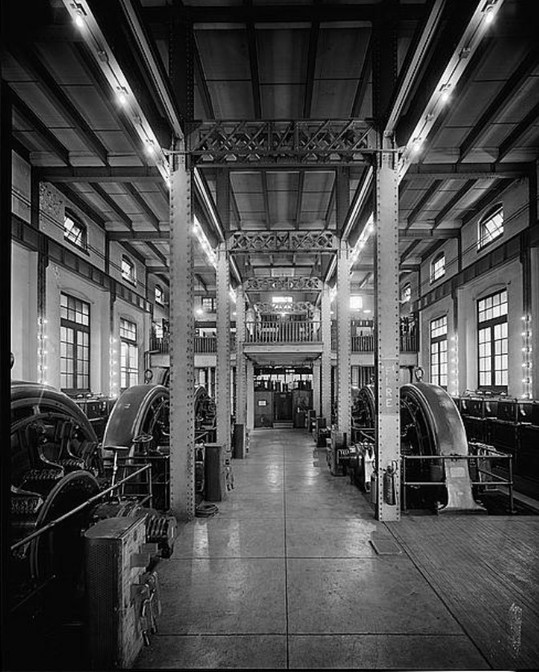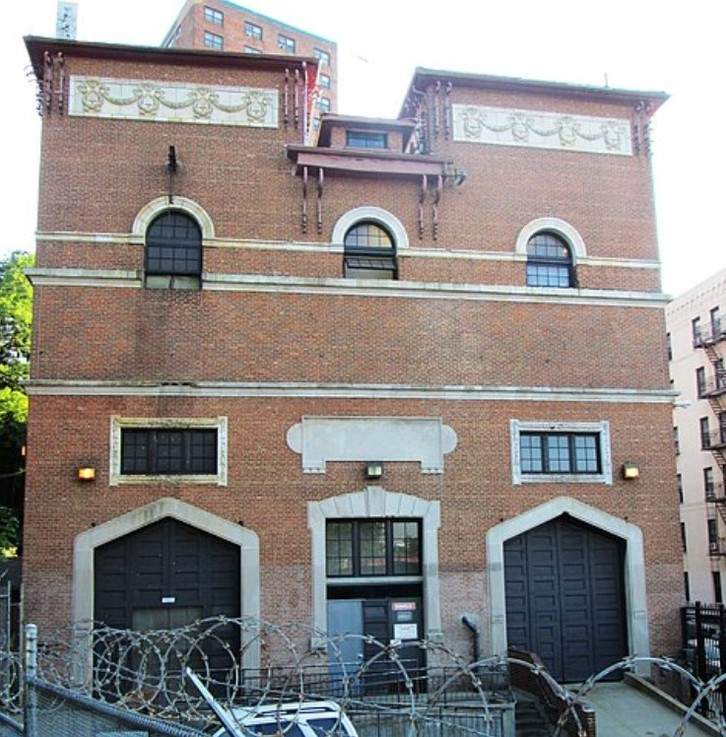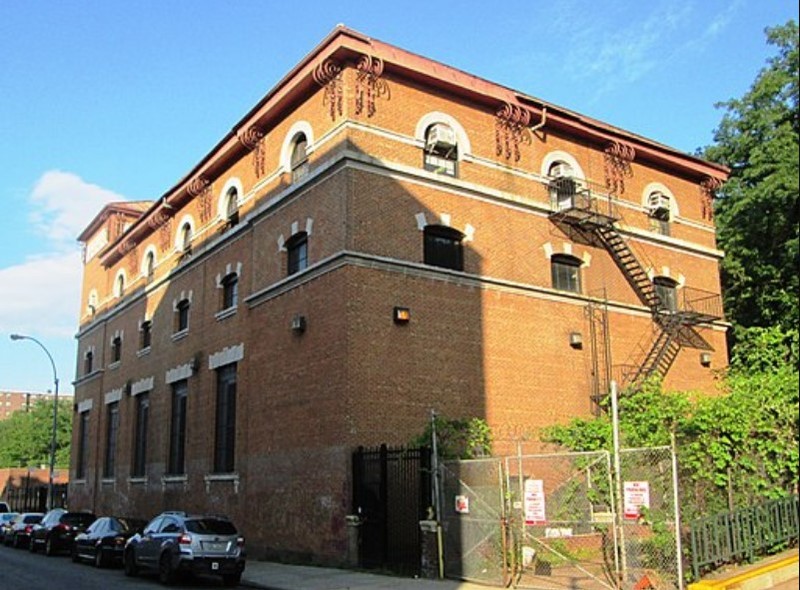Subway Substation 17, Dyckman-Hillside
Introduction
Text-to-speech Audio
Subway Substation 17 is one of the eight original substations built by the Interborough Rapid Transit Company from 1904 to 1905 and continues to support the New York City Subway as a workshop for elevators and escalators in addition to providing backup equipment to support electrical power distribution in the case of a system failure. The substation is near the Fort George Tunnel, one of the deepest portions of the subway system as it passes through hilly northern Manhattan. Subway Substation 17 was listed on the National Register of Historic Places in 2006, and also is known as the Dyckman-Hillside Substation.
Images
2016 view of Subway Substation 17, from Hillside Ave. (NYS CRIS)

Operating room inside Substation 17 in 1978 photo by David Sagarin for Hist. Amer. Engineering Record (HAER NY-122-63)

1918 Map of the New Subway of Greater New York with Dyckman Station (pink arrow) on West Side Subway (Manhattan Publishing Co.)

Front of Substation 17 viewed from Dyckman Street Subway Station in 2014 (Beyond My Ken)

Hillside Avenue and rear facades of Substation 17 in 2014 (Beyond My Ken)

Backstory and Context
Text-to-speech Audio
When plans for building the New York City Subway were being made in the mid-1890s, a visit was made to Europe to examine existing systems. Recent American systems were considered, too, including the elevated Intramural Railway built for the Columbian Exposition in Chicago and the Baltimore Belt Tunnel of the Baltimore and Ohio Railroad, both electric-powered. Steam power was ruled out to avoid the exhaust-filled tunnels as seen in London, and the ventilation requirements. The Board of Rapid Transit Railroad Commissioners considered using compressed air or electricity for power. Electricity was thought to be economical, since poorer grades of coal could be burned efficiently in stationary plants; electric motors had advantages of quicker acceleration, thought to provide higher speeds than steam power.
Construction for the first subway line in New York City was awarded in 1900 to John B. McDonald, who chose to go with electric power. The power system consisted of a single central generating station producing 11,000 volts; alternating current required less copper conductor so costs were lower. The voltage was stepped down to lower voltage at the substations, spaced about two miles apart along the line, and was transformed to direct current. From the substations, power was distributed by cables to a third rail. A collecting "shoe" connected power from the third rail to the railcar motor.
The main power station was built on a block between 11th and 12th Avenues in Manhattan, from 58th to 59th Streets; the 540-foot-long station was built from 1902 to 1903 and was lengthened in 1905 when the proposed line was extended to Brooklyn. McDonald originally hoped to cut costs of land by installing some of the substations underground on public land at places like parks and Longacre (Times) Square, but couldn't get permission. The substations were built very near the line in less developed areas where land was cheaper and more plentiful (like Substation 17); in more densely developed areas, McDonald was able to locate the substations within a half-block of the tracks. It took two adjacent city lots of 25 by 100 feet each to hold a substation structure. The original substations could hold eight to ten rotary converters with sets of transformers.
The Beaux-Arts/ Italianate style Substation 17, located just over 7 miles from the main Power Plant, was designed for up to eight rotary converters but six were installed. The building is two stories tall with a partial mezzanine and full basement, a hipped roof, and tower-like projections on the main facade. Decorative touches to the brick structure are in terra cotta. The design of this first wave of substation building tried to create buildings that were compatible with the neighborhood's architecture; later designs were more utilitarian. Unlike the rest of the system, at Substation 17 a bridge over the track carried the feeder cables to the subway right-of-way; typically, this would be underground.
New York City took over the operation of the subway in 1940. Consolidated Edison Company began operating the rapid transit power plants in 1959 and modernized the equipment and facilities, completely overhauling the 59th Street Main Power Plant. The bridge at Substation 17 was dismantled in the early 1960s and the cables were placed underground.
The Dyckman-Hillside Substation (No. 17) was found to have significance in the areas of architecture, engineering, transportation, and community planning and development. It continues to serve the New York City Subway as an escalator/ elevator shop (by 1994) and is reserved for backup emergency power.
Sources
Fonville, Gary. NYC Subway Substations, Forgotten New York. February 23rd 2008. Accessed November 14th 2021. https://forgotten-ny.com/2008/02/one-of-our-substations-is-missing-some-of-nycs-remaining-subway-and-el-power-sources/.
Katz, Wallace B. Hood, Clifton et al. HAER NY-122, Interborough Rapid Transit Subway (Original Line), New York City, New York. Historic American Engineering Record. Washington, DC. Heritage Conservation and Recreation Service, Dept. of the Interior, 1979.
Kimmelman, Barbara. Design and Construction of the IRT: Electrical Engineering, Historical American Engineering Record NY-122, NYCsubway.org. Accessed November 14th 2021. https://www.nycsubway.org/wiki/Design_and_Construction_of_the_IRT:_Electrical_Engineering_(Kimmelman).
New York City Transit Authority. JB & DS. NYSOPRHP Historical Properties Survey Phase II form, Subway Substation #17. Albany, NY. New York State Office of Parks, Recreation, and Historic Preservation, 1994.
New York State Cultural Resource Information System (NYS CRIS): https://cris.parks.ny.gov/Default.aspx
Library of Congress (LOC): https://www.loc.gov/resource/hhh.ny0387.photos/?sp=63
LOC: https://www.loc.gov/item/2011593040/
https://commons.wikimedia.org/wiki/File:Dyckman-Hillside_Substation_from_Dyckman_Street_station.jpg
https://commons.wikimedia.org/wiki/File:Dyckman-Hillside_Substation_from_rear.jpg
